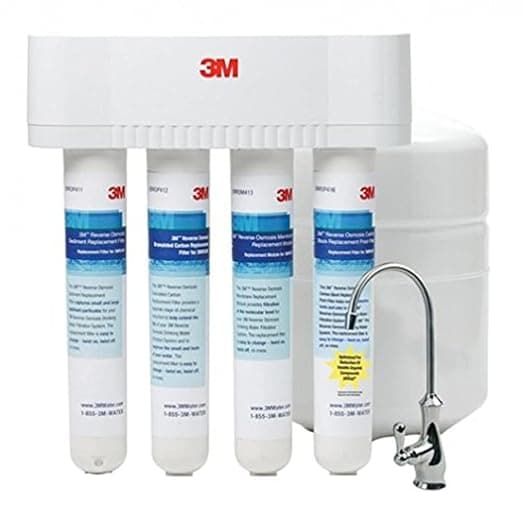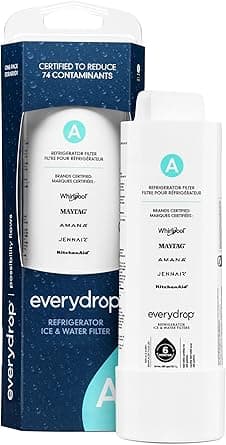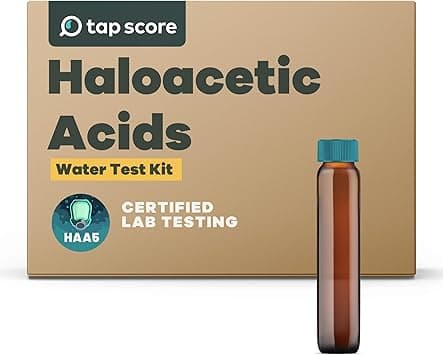Raymondville Tap Water Quality Report
Raymondville's water has 12 contaminants above EPA MCLGs. We recommend using a certified water filter.
Utility
RAYMONDVILLE WATER SYSTEM
People Served
153,705
MCL Violations
0
Last Updated
Jun 27, 2022
Is Raymondville Tap Water Safe to Drink?
Raymondville's water has 12 contaminants above EPA health-based guidelines. We strongly recommend using a certified water filter to reduce exposure to these contaminants. Check our filter recommendations below for NSF-certified options that can remove the specific contaminants found in Raymondville's water.
The data below shows test results from RAYMONDVILLE WATER SYSTEM, which serves 153,705 people in the Raymondville area. Water quality testing is conducted regularly and reported to the EPA. This report was last updated Jun 27, 2022.
Raymondville Water Quality Test Results
Key Water Quality Metrics
Contaminants Detected
⚠️ Contaminants Above EPA MCLG (12)
Bromodichloromethane
What is Bromodichloromethane?
Member of trihalomethanes (THMs) that form in water treated with chlorine
Health Effects
Health protective benchmarks for BDCM are based on carcinogenicity and liver toxicity observed in animal studies. The EPA has classified BDCM as a probable human carcinogen. Results from animal studies also suggest that kidney, immune system, spleen, and developmental toxicity are associated with exposure to BDCM. BDCM has been shown to produce DNA changes (genotoxicity) in laboratory studies.
Affected Organs
Common Sources
Bromoform
What is Bromoform?
Member of trihalomethanes (THMs) that form in water treated with chlorine
Health Effects
Health protective benchmarks for bromoform are based on liver, developmental, and carcinogenicity observed in animal studies. Results from animal studies also suggest that exposure to bromoform can also lead to liver, kidney, and developmental toxicity. Bromoform has also been shown to produce DNA changes (genotoxicity) in laboratory studies.
Affected Organs
Common Sources
Dichloroacetic Acid (DCA)
What is Dichloroacetic Acid (DCA)?
Member of haloacetic acids (HAAs) that form as byproducts when chlorine reacts with organic matter
Health Effects
Health protective benchmarks for DCA are based on evidence of increased cancer risk and liver toxicity observed in animal studies. Adverse effects to the male reproductive system have also been associated with elevated levels of DCA in animal studies. The EPA classifies DCA as a likely human carcinogen.
Affected Organs
Common Sources
Radium, combined (-226 & -228)
What is Radium, combined (-226 & -228)?
Radium is a naturally occurring radioactive metal that is part of the uranium decay series. It is found in trace amounts in soil, rock, and water. Radium is known for its radioactive properties and can emit alpha, beta, and gamma radiation. It is a heavy metal and can be harmful to human health when ingested or inhaled.
Health Effects
Exposure to radium can lead to serious health issues, including an increased risk of cancer, particularly bone cancer. It can also cause damage to the bone marrow and other organs. Long-term exposure may result in anemia, immune system suppression, and other health complications.
Affected Organs
Common Sources
Uranium
What is Uranium?
Uranium is a weakly radioactive heavy metal found naturally in bedrock and used in nuclear weapons, some ceramics, electron microscopy stains, photography toners, and certain fertilizers. Uranium is weakly radioactive because all of its isotopes (Uranium-234, Uranium-235, and Uranium-238) are unstable. Ninety-nine percent of naturally existing uranium is in the isotope form uranium-238. The EPA has established a maximum contaminant level for uranium in drinking water in response to human and animal studies indicating kidney toxicity and and increased risk of cancer.
Health Effects
Health protective benchmarks for uranium are based on adverse kidney system effects observed in both humans and animals and an increased risk of cancer. Animal studies have also shown female reproductive system and developmental toxicity, as well as genotoxicity, related to uranium exposure.
Affected Organs
Common Sources
Dibromoacetic Acid (DBA)
What is Dibromoacetic Acid (DBA)?
Member of haloacetic acids (HAAs) that form as byproducts when chlorine reacts with organic matter
Health Effects
Health protective benchmarks for DBA are based on carcinogenicity and liver toxicity observed in animal studies. The EPA has classified DBA as a probable human carcinogen. Results from animal studies also suggest that kidney, immune system, spleen and developmental toxicity are associated with exposure to BDCM. BDCM has been shown to produce DNA changes (genotoxicity) in laboratory studies.
Affected Organs
Common Sources
n Nitrosodimethylamine
What is n Nitrosodimethylamine?
n-Nitrosodimethylamine (NDMA) is a volatile organic compound that occurs in drinking water as a byproduct of disinfection using chlorine or chloramines. It was once used to produce liquid rocket fuel, antioxidants, softeners, and lubricants. NDMA is readily volatile, thus all routes of exposure (ingestion, inhalation and dermal) are relevant if one is exposed via drinking water.
Health Effects
Health protective benchmarks for NDMA have been developed based on a potential increased risk of cancer. The EPA classifies NDMA as a probable human carcinogen.
Affected Organs
Common Sources
Total THMs
What is Total THMs?
Group of contaminants that form in drinking water systems when a disinfectant, typically chlorine, reacts with organic matter
Health Effects
Drinking water standards for total THMs are based on evidence of carcinogenicity in human and animal studies, as well as liver and kidney toxicity observed in animal studies. Individual THMs have been further associated with developmental, immune, spleen, and genotoxicity.
Affected Organs
Common Sources
Dibromochloromethane
What is Dibromochloromethane?
Member of trihalomethanes (THMs) that form in water treated with chlorine
Health Effects
Health protective benchmarks for DBCM have been developed based on liver toxicity and carcinogenicity observed in animal studies. EPA has classified DBCM as a possible human carcinogen based on animal evidence, while IARC (International Agency for Research on Cancer) says it is unclassifiable as a human carcinogen. Kidney toxicity has also been associated with DBCM based on evidence from animal studies. DBCM has been shown to produce DNA changes (genotoxicity) in laboratory studies.
Affected Organs
Common Sources
Chloroform
What is Chloroform?
Member of trihalomethanes (THMs) that form in water treated with chlorine and is generally the most abundant THM formed in drinking water
Health Effects
Health protective benchmarks for chloroform have been developed based on kidney and liver carcinogenicity observed in animal studies, and liver toxicity observed in occupational studies. The EPA classifies chloroform as a probable human carcinogen based on animal evidence, and there is additional epidemiological evidence that may increase the risk of colon and bladder cancer in humans. Results from animal studies also suggest that exposure to chloroform can cause liver, developmental and immune toxicity. Acute exposure to low levels of chloroform will cause nervous system toxicity.
Affected Organs
Common Sources
Trichloroacetic Acid (TCA)
What is Trichloroacetic Acid (TCA)?
Member of haloacetic acids (HAAs) that form as byproducts when chlorine reacts with organic matter
Health Effects
Health protective benchmarks for TCA in drinking water have been developed based on liver toxicity and carcinogenicity observed in animal studies. EPA has classified TCA as a possible human carcinogen. Developmental toxicity has also been associated with exposure to TCA based on evidence from animal studies.
Affected Organs
Common Sources
Chlorite
What is Chlorite?
Chlorite is a chemical compound that is a derivative of chloric acid. It is often found in drinking water as a byproduct of chlorine disinfection processes. Chlorite can also occur naturally in some water sources.
Health Effects
Exposure to chlorite can lead to various health issues, including irritation of the skin, eyes, and respiratory tract. Ingesting high levels of chlorite can cause gastrointestinal distress and may affect red blood cell function, leading to methemoglobinemia, a condition where the blood cannot carry oxygen effectively.
Affected Organs
Common Sources
Understanding the Data
This data comes from your local water utility testing. The bar charts compare detected levels against EPA's Maximum Contaminant Level Goal (MCLG). Contaminants above the MCLG are shown by default and may require filtration. All other tested contaminants are within safe levels and can be viewed by expanding the section above.
Recommended Water Filters for Raymondville
Based on Raymondville's water quality data, these NSF-certified filters are recommended to remove contaminants above EPA MCLGs.

Solventum Purification Inc.
3MRO401
NSF Certified:
Daily Production
11.48 gpd
Removes 15 contaminants:
Arsenic, Barium, Cadmium, Chromium (Total), Chromium (VI) +10 more

Solventum Purification Inc.
3MRO301
NSF Certified:
Daily Production
11.48 gpd
Removes 15 contaminants:
Arsenic, Barium, Cadmium, Chromium (Total), Chromium (VI) +10 more

Whirlpool Corporation
W11256135
NSF Certified:
Capacity
1001 gal
Filter Life
3 mo
Flow Rate
0.7 gpm
Removes 19 contaminants:
1,2 Dichlorobenzene, 1,4 Dichlorobenzene, 2,4-D, Asbestos, Atrazine +14 more

Whirlpool Corporation
W11569861
NSF Certified:
Capacity
1001 gal
Filter Life
3 mo
Flow Rate
0.52 gpm
Removes 22 contaminants:
1,2 Dichlorobenzene, 1,2,4 Trichlorobenzene, 1,4 Dichlorobenzene, 2,4-D, Asbestos +17 more
Verify Your Water Quality with Independent Testing
With 12 contaminants above EPA health guidelines, independent laboratory testing provides a second opinion and can track changes over time.

SimpleLab
Advanced Home Water Test
$369
Most comprehensive home water test including all standard tests plus additional parameters for ultimate peace of mind.

SimpleLab
Standard Home Water Test
$232
Comprehensive water analysis testing over 200 contaminants including bacteria, heavy metals, and chemical compounds.

Tap Score
Haloacetic Acids (HAA9) Test
$275
Tests for disinfection byproducts formed when chlorine reacts with organic matter in water treatment.
Frequently Asked Questions About Raymondville Tap Water
Raymondville's water has 12 contaminants above EPA MCLGs. We strongly recommend using a certified water filter to reduce exposure to these contaminants. Check our filter recommendations below for NSF-certified options that can remove the specific contaminants found in Raymondville's water.